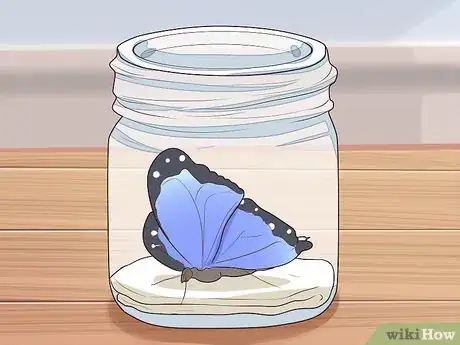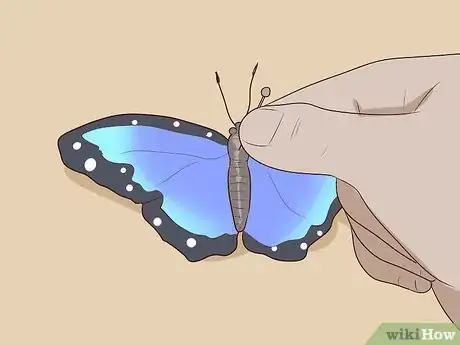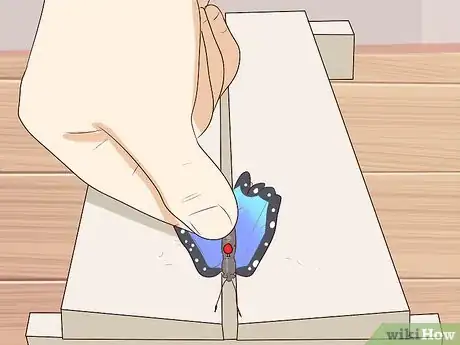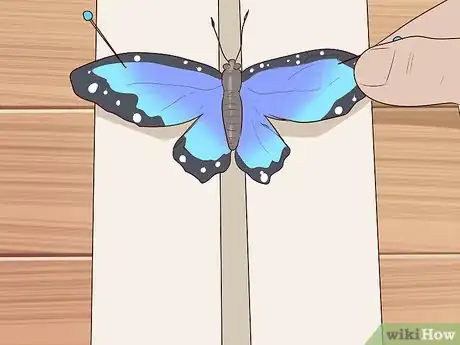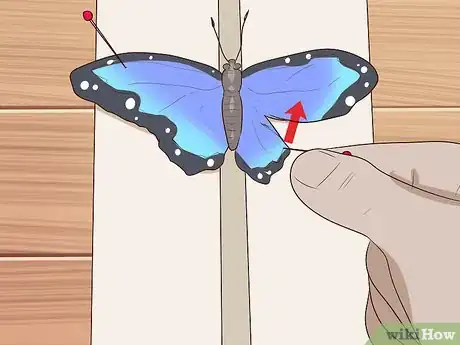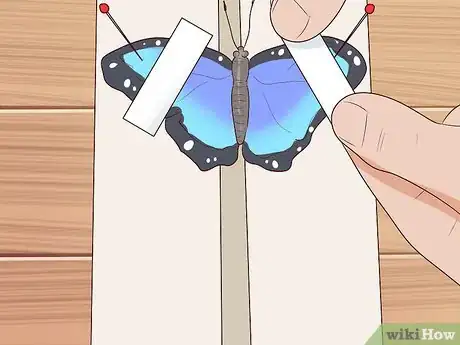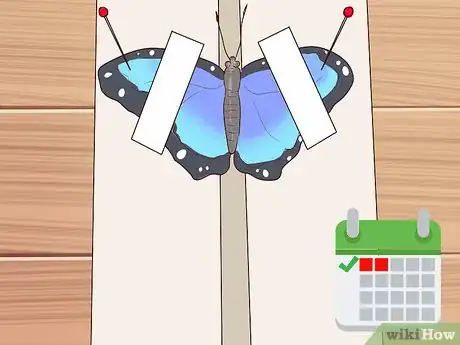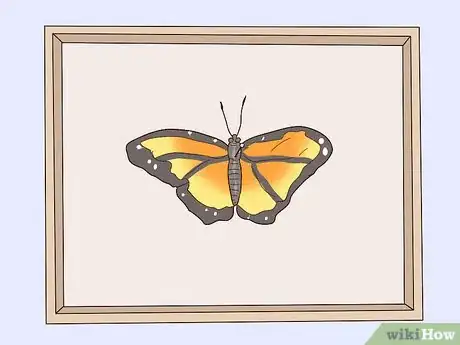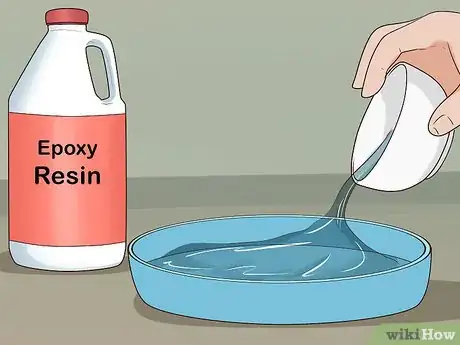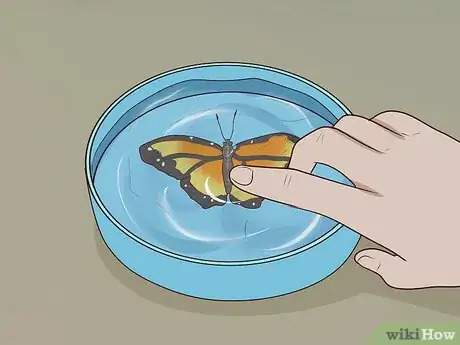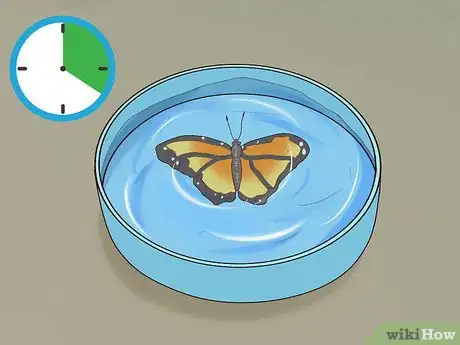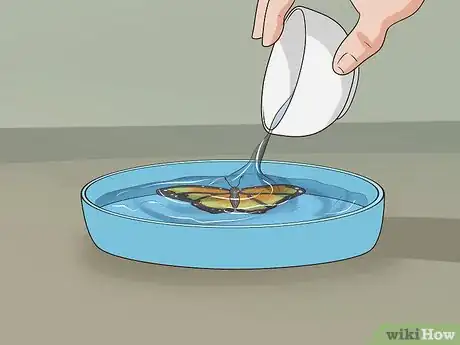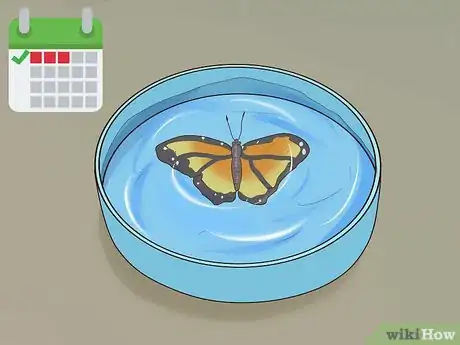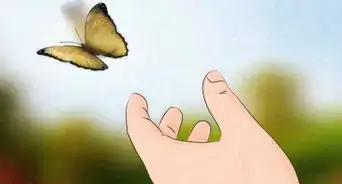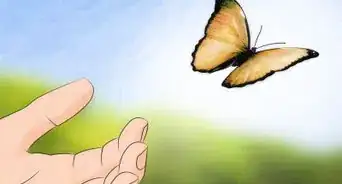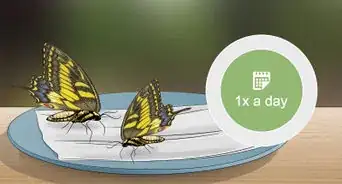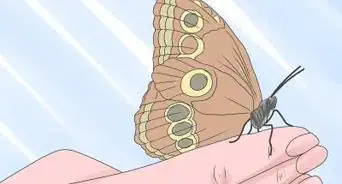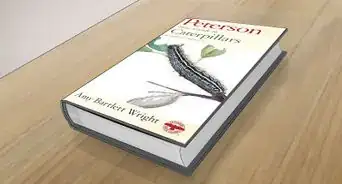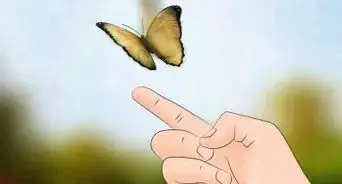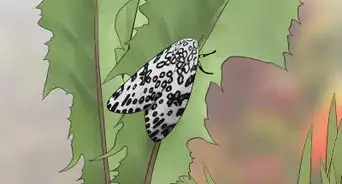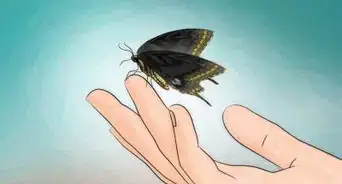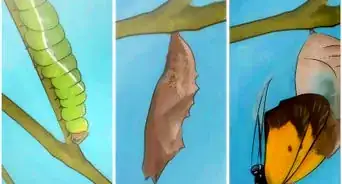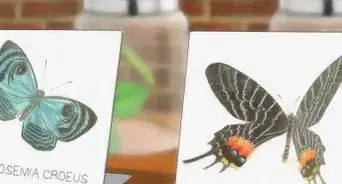This article was co-authored by Samuel Ramsey, PhD and by wikiHow staff writer, Hunter Rising. Dr. Samuel Ramsey is an Entomologist and a researcher with the United States Department of Agriculture. Dr. Ramsey has extensive knowledge of symbiosis and specializes in insect disease spread, parasite behavior, mutualism development, biological control, invasive species ecology, pollinator health, and insect pest control. He holds a Bachelor’s degree in Entomology from Cornell University and a Ph.D. in Entomology from the University of Maryland. Dr. Ramsey’s research on bees has enabled researchers to develop targeted control techniques to restore honey bee populations worldwide. He also hosts a YouTube series called “Dr. Buggs.”
There are 11 references cited in this article, which can be found at the bottom of the page.
This article has been viewed 173,616 times.
Butterflies are beautiful to look at, and collectors enjoy preserving multiple species to admire their wing patterns. If you’ve found a dead butterfly or captured one that you want to save, you can either pin it in a display case or encapsulate it in a clear epoxy resin. No matter how you display your butterfly, you need to first mount it into the position you want. When you’re finished, you’ll have a beautiful display that can last a lifetime!
Steps
Mounting Your Butterfly
-
1Place the butterfly in a jar with a wet paper towel for 2-7 days. When butterflies die, their bodies become very brittle and will break apart easily unless they’re relaxed. Wet a paper towel with warm water and set it on the bottom of a glass jar with a lid. Pour in 1 teaspoon (4.9 ml) of antiseptic like Lysol into the bottom to prevent mold from forming. Set the butterfly in the jar and seal it for 2-7 days.[1]
- Smaller butterflies that are only 1–3 inches (2.5–7.6 cm) long will only take about 2 days to relax, while larger butterflies will take up to 1 week.
- If your butterfly doesn’t fit in a jar, you may also use a plastic container with a lid.
-
2Push a mounting pin through the center of the butterfly’s thorax. Once the butterfly is relaxed, take it out of the glass jar and carefully stick an insect mounting pin through the middle of the butterfly’s thorax, or the middle body section.[2] Use a spade-tip forceps to slightly spread the butterfly’s wings apart if they aren’t already open. Push the pin through so one-third of its length sticks out from the bottom of your butterfly.[3]
- Insect mounting pins can be purchased online or in specialty science and lab equipment stores.
- Insect pins come in many different sizes, but you only need #2 or #3 pins with a diameter of about 1⁄50 in (0.51 mm).
Advertisement -
3Set the butterfly’s body in the spreading board. Spreading boards are used for preserving insects so you can spread out their wings to dry. Grab the butterfly by its body using your fingers or a pair of forceps and place it in the center of your spreading board. Push the pin about 1⁄2 in (1.3 cm) into the board so it stays in place. Slide the butterfly’s body down the pin until the wings are level with the sides of the board.[4]
- Spreading boards can be purchased online in a fixed or adjustable size.
-
4Spread and pin the top wings out so they’re perpendicular to the butterfly’s body. Stick a pin through the main vein along the top of the butterfly’s wing about 1⁄4–1⁄2 in (0.64–1.27 cm) from its body. Hold the butterfly’s body steady with your non-dominant hand and slowly pull the top wing open using the pin with your dominant hand. When the bottom of the wing makes a 90-degree angle with the butterfly’s body, stick the pin into your board. Repeat the process on the other side of the butterfly.[5]
- Avoid touching the butterfly’s wings with your hands since you may accidentally rub off the scales.
- You can also choose to have the bottom line of the top wing be perpendicular to the body. (That's how other people do it.)
-
5Open the bottom wings until the pattern lines up with the top wings. Once the top wings are pinned to your mounting board, lightly push another pin on the top edge of the bottom wing. Do not pierce through the butterfly’s wing, but gently push it open instead. Slide the bottom wings underneath the top wings until the patterns between them line up with one another.[6]
- The bottom wings do not need to be secured with pins.
-
6Hold the wings flat with a strip of wax paper. Cut out 2 strips of wax paper that are 1⁄2 in (1.3 cm) wide and 2 in (5.1 cm) longer than the height of the butterfly’s wings. Hold the pieces of wax paper across butterfly’s wings and secure them in place with pins. Put the pins directly above the top wings and below the bottom wings so they don’t move or curl while they dry..[7]
- You can make the wax paper wider/longer.
Tip: If you’re preserving multiple butterflies on the same mounting board, cut strips of wax paper as long as the board and place a pin on the tops and bottoms of each butterfly’s wing.
-
7Let the butterfly dry on the board for 2 days before removing the pins around the wings. Leave the butterfly in a cool, dry place out of direct sunlight, such as a kitchen counter or on a desk. Once the butterfly is completely dry, remove the pins and paper around the butterfly’s wings from your mounting board.[8]
- Drying time may take longer depending on the size of your butterfly.
- Be careful handling your butterfly once it’s dry since it will be very fragile.
- If you plan on preserving your butterfly in resin instead of in a display case, remove the pin from its thorax.
Pinning a Butterfly in a Display Case
-
1Stick your butterfly into the foam backing of the display case. Use the pin already going through the butterfly’s thorax. Get an insect display case or shadow box with a foam backing so you can easily hang your butterfly.[9] Open the front of the case and press the pin into the back by about 1⁄2 in (1.3 cm).[10]
- Shadow boxes and insect display cases can be purchased online or you can make your own.
- Keep multiple butterflies or insects in your display case, or use multiple smaller case to make a wall collage.
-
2Label the butterfly if you want to remember the species. Use a small strip of paper as a label, and write the name of the butterfly on it. Secure it next to the butterfly using mounting pins so you don’t forget what species you have preserved.[11]
Tip: Use the species’ scientific name to make your butterfly collection look more academic.
-
3Seal the display case so it’s airtight and hang it. Put the cover back on your display case and make sure it’s closed to keep your butterfly completely preserved. Hang your display case in a well-lit area but out of direct sunlight.[12]
- Keep mothballs in the case if you aren’t hanging it right away so your butterflies don’t start to mold.
- If you keep your butterfly in sunlight, the color of its wings might fade.
Preserving a Butterfly in Resin
-
1Pour a thin base layer of clear resin into a mold. Mix a clear epoxy resin in a plastic container, following the directions on the back of the package. Use a rubber mold that’s 1–2 in (2.5–5.1 cm) wider than your butterfly’s wingspan in any shape, such as a flat disc, a rectangular prism, or a round sphere. Fill the bottom of the mold with about 1⁄4–1⁄2 in (0.64–1.27 cm) of the resin. Pour the resin slowly to prevent any air bubbles from forming.[13]
- Resin can be purchased at any hardware store.
- Rubber molds made for resin can be purchased online.
-
2Set the butterfly in the center of your resin. Pinch the body of your butterfly between your fingers or with a pair of spade-tip forceps. Carefully set the butterfly in the middle of your mold so it’s partially submerged by the resin.[14]
- Be careful while handling your butterfly since it will be fragile and could break apart.
-
3Let the resin set for 15-20 minutes until it gels. As your resin dries, it will first form into a gel before it completely hardens. Cover your mold with a container so the resin dries faster. Leave the resin alone for 15-20 minutes so it can start to solidify.[15]
- Don’t let your resin set completely or else the other layers of resin will not adhere to it.
-
4Cover the rest of the butterfly with your resin. Slowly pour the remainder of your resin around the butterfly so you don’t damage the wings. Completely cover the butterfly so it’s encased in the resin and filled to the top of the mold.[16]
- Maintain a slow and constant pour so air bubbles don’t form inside your resin.
-
5Let the resin cure for 3 days before popping it out of the mold. Leave the mold in a cool, dry place so your mold can cure properly. Give your resin at least 3 days to cure so it can completely harden. Once the resin is finished drying, peel back the rubber mold to remove the resin.[17]
- Use your resin butterfly as a table decoration or as a paperweight.
Expert Q&A
Did you know you can get expert answers for this article?
Unlock expert answers by supporting wikiHow
-
QuestionHow do you mount a butterfly?
 Samuel Ramsey, PhDDr. Samuel Ramsey is an Entomologist and a researcher with the United States Department of Agriculture. Dr. Ramsey has extensive knowledge of symbiosis and specializes in insect disease spread, parasite behavior, mutualism development, biological control, invasive species ecology, pollinator health, and insect pest control. He holds a Bachelor’s degree in Entomology from Cornell University and a Ph.D. in Entomology from the University of Maryland. Dr. Ramsey’s research on bees has enabled researchers to develop targeted control techniques to restore honey bee populations worldwide. He also hosts a YouTube series called “Dr. Buggs.”
Samuel Ramsey, PhDDr. Samuel Ramsey is an Entomologist and a researcher with the United States Department of Agriculture. Dr. Ramsey has extensive knowledge of symbiosis and specializes in insect disease spread, parasite behavior, mutualism development, biological control, invasive species ecology, pollinator health, and insect pest control. He holds a Bachelor’s degree in Entomology from Cornell University and a Ph.D. in Entomology from the University of Maryland. Dr. Ramsey’s research on bees has enabled researchers to develop targeted control techniques to restore honey bee populations worldwide. He also hosts a YouTube series called “Dr. Buggs.”
Entomologist
-
QuestionHow should you store a preserved butterfly?
 Samuel Ramsey, PhDDr. Samuel Ramsey is an Entomologist and a researcher with the United States Department of Agriculture. Dr. Ramsey has extensive knowledge of symbiosis and specializes in insect disease spread, parasite behavior, mutualism development, biological control, invasive species ecology, pollinator health, and insect pest control. He holds a Bachelor’s degree in Entomology from Cornell University and a Ph.D. in Entomology from the University of Maryland. Dr. Ramsey’s research on bees has enabled researchers to develop targeted control techniques to restore honey bee populations worldwide. He also hosts a YouTube series called “Dr. Buggs.”
Samuel Ramsey, PhDDr. Samuel Ramsey is an Entomologist and a researcher with the United States Department of Agriculture. Dr. Ramsey has extensive knowledge of symbiosis and specializes in insect disease spread, parasite behavior, mutualism development, biological control, invasive species ecology, pollinator health, and insect pest control. He holds a Bachelor’s degree in Entomology from Cornell University and a Ph.D. in Entomology from the University of Maryland. Dr. Ramsey’s research on bees has enabled researchers to develop targeted control techniques to restore honey bee populations worldwide. He also hosts a YouTube series called “Dr. Buggs.”
Entomologist
Things You’ll Need
Mounting Your Butterfly
- Glass jar
- Paper towel
- Antiseptic
- Mounting pins
- Spreading board
- Spade-tip forceps
- Wax paper
Pinning a Butterfly in a Display Case
- Display case with foam backing
- Labels
Preserving a Butterfly in Resin
- Clear epoxy resin
- Rubber mold
- Spade-tip forceps
References
- ↑ https://bughunter.tamu.edu/collecting-and-preserving-butterflies/
- ↑ Samuel Ramsey, PhD. Entomologist. Expert Interview. 20 January 2021.
- ↑ https://bughunter.tamu.edu/collecting-and-preserving-butterflies/
- ↑ https://www.homesciencetools.com/content/reference/IN-INSEPIN.pdf
- ↑ https://youtu.be/fO1u-wIaoO8?t=141
- ↑ https://youtu.be/fO1u-wIaoO8?t=170
- ↑ https://youtu.be/fO1u-wIaoO8?t=184
- ↑ https://www.homesciencetools.com/content/reference/IN-INSEPIN.pdf
- ↑ Samuel Ramsey, PhD. Entomologist. Expert Interview. 20 January 2021.
- ↑ https://www.homesciencetools.com/content/reference/IN-INSEPIN.pdf
- ↑ https://bughunter.tamu.edu/collecting-and-preserving-butterflies/
- ↑ https://www.homesciencetools.com/content/reference/IN-INSEPIN.pdf
- ↑ https://youtu.be/Zaz7S-pSMW4?t=93
- ↑ https://youtu.be/Zaz7S-pSMW4?t=97
- ↑ https://youtu.be/o-Z6KxQUra8?t=195
- ↑ https://youtu.be/Zaz7S-pSMW4?t=147
- ↑ https://youtu.be/Zaz7S-pSMW4?t=177
About This Article
Preserving a butterfly is a unique and beautiful way to decorate your home. You’ll need a jar, pin, spreading board, display case, wax paper, and antiseptic. To stop your butterfly from decaying, place it in a sealed jar on a piece of wet paper towel. Then, pour in 1 teaspoon of antiseptic like Lysol. After 7 days, remove the butterfly and pin it to your spreading board by its neck and both wings. Place a strip of wax paper over each wing to keep them flat and leave it for 2 days. At this point, all you need to do is seal your butterfly in a display case so it’s airtight, and hang it on the wall. For more tips, including how to preserve a butterfly in resin, read on!
